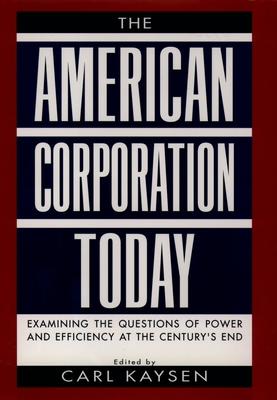Not since Edward Mason’s classic book The Corporation in Modern Society appeared in 1959 has anyone compiled an authoritative overview of the American business firm. Such a survey is now clearly overdue, for in the last thirty years both the corporation and the business environment has changed radically. In The American Corporation Today, Carl Kaysen and other leading students of business and markets from around the country provide a much-needed analysis of American corporate life at the end of the century.
Here is the American corporation from every angle--its postwar history, its relation to the law, its financing, its impact on technological innovation, its role as employer and as political force, and much more. The contributors--all of whom are recognized experts in their fields--not only tackle many of the same key areas that the contributors to Mason’s classic study looked at, but they also illuminate issues that have only arisen in recent years. For instance, Raymond Vernon describes the increasing globalization of American business, where the net income from operations outside the U.S. is now nearly half of that from domestic operations (as opposed to one-tenth in the 1950s). James Q. Wilson traces how the corporation has become a full-time political actor, showing how it reinvented its political strategy and tactics in the 1960s in the face of a wave of new consumer, environmental, and worker health legislation. Gregory Acs and Eugene Steuerle show how the corporation promotes the commonweal, acting as agent for the employee in purchasing pension, health, and other welfare benefit plans, while Lester Thurow casts a critical eye at the decline of median real wages of American males over the last twenty years (never before have a majority of American workers suffered real wage reductions while the real per capita gross domestic product was increasing). In other pieces, corporate finance experts Charles Calomiris and Carlos Ramirez advocate removing legal constraints on financial institutions that prevent them from providing the full range of business financing from short-term debt to equity, Michael Useem looks at the rise of education and training as a vexing corporate issue, and Barbara Bergmann discusses the increasingly diverse work force, arguing that ending bias is in the corporation’s best interest. And finally Neil Harris provides a fascinating discussion of architecture, exploring how companies have become the principle patrons of important architecture since the 1950s.
Vital to everyone concerned with American big business today, this collection is sure to become the new standard upon which future studies of the corporation will be built.
| FindBook |
有 1 項符合
The American Corporation Today的圖書 |
 |
The American Corporation Today 作者:Kaysen 出版社:Oxford University Press, USA 出版日期:1996-10-31 語言:英文 規格:精裝 / 512頁 / 24.08 x 16.31 x 3.99 cm / 普通級/ 初版 |
| 圖書館借閱 |
| 國家圖書館 | 全國圖書書目資訊網 | 國立公共資訊圖書館 | 電子書服務平台 | MetaCat 跨館整合查詢 |
| 臺北市立圖書館 | 新北市立圖書館 | 基隆市公共圖書館 | 桃園市立圖書館 | 新竹縣公共圖書館 |
| 苗栗縣立圖書館 | 臺中市立圖書館 | 彰化縣公共圖書館 | 南投縣文化局 | 雲林縣公共圖書館 |
| 嘉義縣圖書館 | 臺南市立圖書館 | 高雄市立圖書館 | 屏東縣公共圖書館 | 宜蘭縣公共圖書館 |
| 花蓮縣文化局 | 臺東縣文化處 |
|
|
圖書介紹 - 資料來源:博客來 評分:
圖書名稱:The American Corporation Today
內容簡介
|











